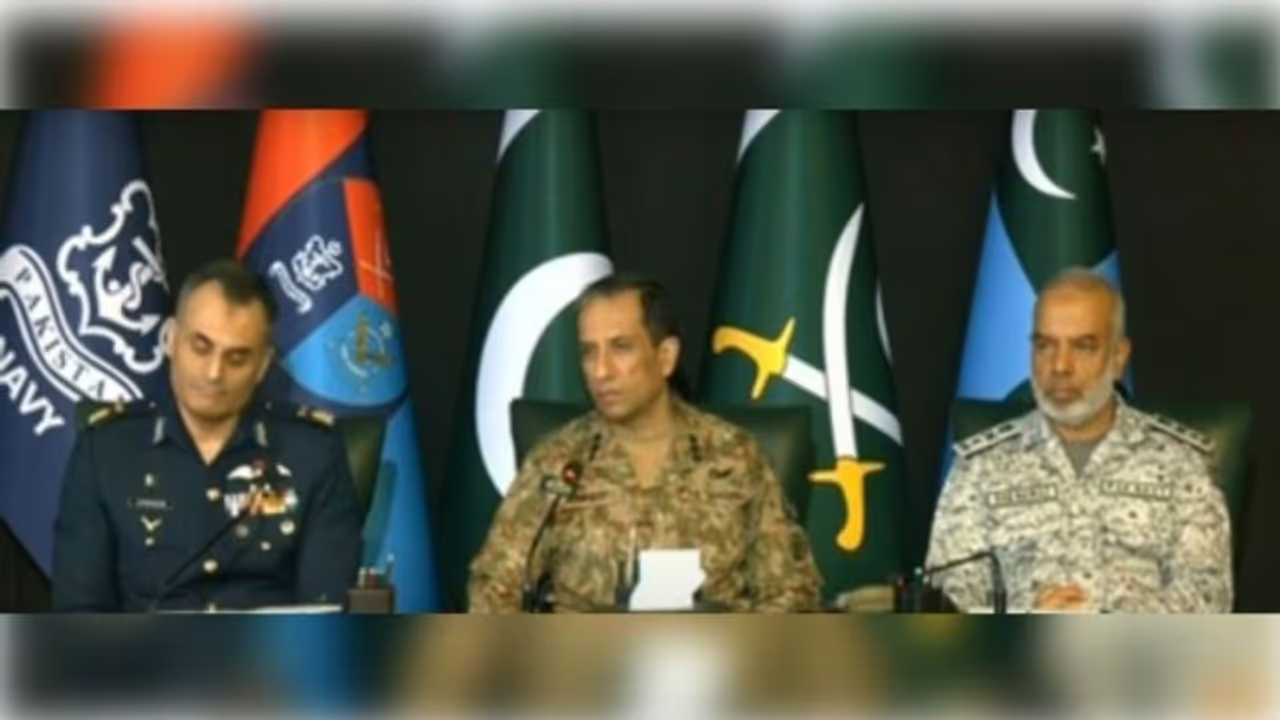Global media ridiculed Pakistan’s press conference as a ‘copycat’ of India’s Operation Sindoor briefing. Pakistan’s ISPR chief claimed 26 Indian bases hit and 84 drones downed. India, by contrast, gave detailed terror targets and casualty figures.
On May 11, Pakistan’s Inter-Services Public Relations (ISPR) chief Lt. Gen. Ahmed Sharif Chaudhary held a media briefing to present Islamabad’s account of the recent clashes. He asserted that Pakistan’s forces had struck 26 Indian military facilities and shot down about 84 Indian drones. He also claimed to have destroyed BrahMos missile launch sites and hit Russia-made S-400 air defence batteries on Indian soil.

Pakistan said these targets were the bases used to launch strikes that killed Pakistani civilians, and implied it was avenging those losses.
Targets hit: According to the claims, India's Suratgarh, Sirsa, Bhuj, Naliya, Adampur, Bhatinda, Barnala, Halwara, Awantipora, Srinagar, Jammu, Udhampur, Mamon, Ambala and Pathankot were heavily damaged by Pakistani strikes.
Drones downed: The ISPR stated 84 Indian drones were shot down over Pakistani airspace.
Advanced systems: Chaudhary alleged that BrahMos missile facilities were destroyed and S-400 batteries at Udhampur and Bhuj were ‘attacked’ by Pakistani jets.
These claims were announced without accompanying evidence. Observers noted that Pakistan’s presentation contained no videos, satellite images or verifiable data to back the assertions.
India quickly dismissed the allegations. In a press briefing on May 10, an Indian Army spokesperson pointedly said Pakistan’s claim of damaging India’s BrahMos and S-400 sites ‘is completely wrong’.
The Indian External Affairs Ministry also flagged those images as recycled from old incidents, underscoring that Pakistan’s version was part of a broader “misinformation campaign”.
In short, Islamabad made broad claims about strikes and destruction, but did not produce independent confirmation.
India’s Operation Sindoor briefing
India, by contrast, had held its own detailed briefings about Operation Sindoor, the counter-strike carried out after the April 22 Pahalgam terror attack. In these briefings (on May 10–11), Indian officials explained that the operation was a “measured” strike on terror infrastructure in Pakistan and Pakistan-occupied Kashmir.
They said the IAF and Army hit nine militant training camps, including Jaish-e-Mohammed bases, with precise targeting. Over 100 terrorists were reported killed, and about 35–40 Pakistani soldiers were also killed in the exchanges.
Indian commanders showed satellite imagery, videos and reconnaissance photos of the struck camps and launch pads. For example, Air Marshal AK Bharti and other service chiefs played footage of missile strikes on those terror hideouts, accompanied by hymns and verses, demonstrating the hits. The focus was on precise “terror camps” and militant targets, not civilian areas, and the figures and visuals were laid out in detail. This evidence-rich approach was a contrast to Pakistan’s press conference, highlighting exactly which insurgent locations were destroyed.
Global reaction and credibility gap
The disparity between the two briefings did not go unnoticed. International media and analysts broadly mocked Pakistan’s presentation. An IANS report noted that “media outlets across the world have ridiculed the failed attempt by Pakistan to imitate India’s … press briefings.
An Australian network bluntly said Pakistan’s conference was “an imitation of the Indian press conference with none of the impressive visuals or proofs to back up their claims."
Even Sky News Australia ran a segment titled “Pakistan ridiculed after imitating India’s press conference, showing excerpts of Pakistan’s briefing followed by social media posts scolding Islamabad for offering ‘no videos, footage or proof’ of its assertions.

Social media users piled on too. One user on X (Twitter) quipped: 'Total copycat of the Indian Army’s style… ZERO proof'. Another joked that after India’s ‘intel-packed briefing’, Pakistan’s looked like ‘a school project gone wrong’. Foreign commentators highlighted that India had provided ‘videos, satellite images and proofs’ of its strikes, whereas Pakistan countered only with ‘WhatsApp forwards and PowerPoint fairytales’.
In short, many observers saw Pakistan’s press conference as a thin, unsubstantiated echo of India’s evidence-backed briefing. The overall international perception has been that Pakistan’s account lacks credibility. Analysts stress the “credibility gap”: India’s statements are backed by data, while Pakistan’s remain unverified and widely doubted.
In practice, this press conference did little to convince external experts. Instead, it became a global spectacle of Pakistan trying to mimic India’s style – and failing to provide any proof.
Ceasefire and aftermath
Meanwhile, diplomatic efforts moved forward. After days of exchange, both countries agreed to a ceasefire on May 10. Pakistani officials credited US mediation for securing the halt. Dawn reported that US President Donald Trump posted on social media that ‘India and Pakistan have agreed to a full and immediate ceasefire’ after overnight talk.
India’s Foreign Secretary Vikram Misri said both sides’ military commanders had agreed that all firing would stop by 5:00 PM IST (4:30 PM PKT) on May 10. The truce held after that point, even though soon after Pakistan violated the ceasefire.
Prime Minister Shehbaz Sharif thanked President Trump for the 'immediate ceasefire', framing it as a victory for diplomacy. Indian officials similarly expressed relief that the fighting had ended.
As of now, both armies have paused active operations. However, the public narrative battle continues. While India’s account (backed by images and figures) has been largely accepted internationally, Pakistan’s ‘copycat’ briefing remains widely seen as a dubious recapitulation.
Observers note that Pakistan’s credibility on these claims has suffered sharply, and that the country’s global image took a hit by apparently staging a press conference without evidence.
Overall, experts say the episode highlights the importance of transparency in military communications. India’s detailed, evidence-based briefing is being praised for clarity, while Pakistan’s claims have largely been disbelieved.


